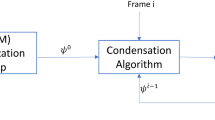Abstract
This paper presents the boundary detection of atrium and ventricle in echocardiographic images. In case of mitral regurgitation, atrium and ventricle may get dilated. To examine this, doctors draw the boundary manually. Here the aim of this paper is to evolve the automatic boundary detection for carrying out segmentation of echocardiography images. Active contour method is selected for this purpose. There is an enhancement of Chan–Vese paper on active contours without edges. Our algorithm is based on Chan–Vese paper active contours without edges, but it is much faster than Chan–Vese model. Here we have developed a method by which it is possible to detect much faster the echocardiographic boundaries. The method is based on the region information of an image. The region-based force provides a global segmentation with variational flow robust to noise. Implementation is based on level set theory so it easy to deal with topological changes. In this paper, Newton–Raphson method is used which makes possible the fast boundary detection.









Similar content being viewed by others
References
Jones EC, Devereux RB, Roman MJ: Prevalence and correlates of mitral regurgitation in a population-based sample (the Strong Heart Study). Am J Cardiol 87:298–304, 2001
Bach DS, Michael Deeb G, Boiling SF: Accuracy of intraoperative transesophageal echocardiography for estimating the severity of functional mitral regurgitation. Am J Cardiol 76:508–512, 1995
Smith MD, Cassidy JM, Gurley JC, Smith AC, Booth DC: Echo Doppler evaluation of patients with acute mitral regurgitation: Superiority of transesophageal echocardiography with color flow imaging. Am Hear J 129(5):167–174, 1995
Aotsuka H, Tobita K, Hamada H, Uchishiba M, Tateno S, Matsuo K, Fujiwara T, Niwa K: Validation of the proximal isovelocity surface area method for assessing mitral regurgitation in children. Pediatr Cardiol 17(6):351–359, 1996
Enriquez-Sarano M, Basmadjian A-J, Rossi A, Baile KR, Seward JB, Jamil Tajik A: Progression of mitral regurgitation. A prospective Doppler echocardiographic study. J Am Coll Cardiol 34(4):1137–1144, 1999
Santamore WP, Dimeo FN, Lynch PR: A comparative study of various single-plane cineangiocardiographic methods to measure left-ventricular volume. IEEE Trans Biomed Eng BME-20(6):417–421, 1973
Bartunek J, Vantrimpont PJ, De Bruyne B: Left atrial volume determination by echocardiography. Validation by biplane angiography in the setting of mitral balloon valvuloplasty. Intern J Card Imaging 10:263–268, 1994
Torp AH, Rabben SI, Støylen A, Ihlen H, Andersen K, ke Brodin L-Å, Olstad B: Automatic Detection and Tracking of Left Ventricular Landmarks in Echocardiography, IEEE Ultrasonics Symposium, 2004, pp 474–477
KaChanoura N, Delouche A, Herment A, Frouin F, Diebold B: Automatic detection of end systole within a sequence of left ventricular echocardiographic images using autocorrelation and mitral valve motion detection. In: Proceedings of the 29th Annual International Conference of the IEEE EMBS Cité Internationale, Lyon, France, 2007, pp 4504–4507
Watton PN, Luo XY, Yin M, Bernacca GM, Wheatley DJ: Effect of ventricle motion on the dynamic behaviour of chorded mitral valves. J Fluids Struct 24:58–74, 2008
Hunter IA, Soraghan JJ, McDonaght T: Fully automatic left ventricular boundary extraction in echocardiographic images. Comput Cardiol, 741–744, 1995
Ohyama W, Wakabayashi T, Kimura F, Tsuruoka S, Sekioka K: Automatic left ventricular endocardium detection in echocardiograms based on ternary thresholding method, In: Proceedings 15th International Conference On Pattern Recognition, 2000, pp 181–183
Hansegård J, Steen E, Rabben SI, Torp AH, Torp H, Frigstad S, Olstad B: Knowledge based extraction of the left ventricular endocardial boundary from 2D echocardiograms. In: IEEE International Ultrasonics, Ferroelectrics, and Frequency Control Joint 50th Anniversary Conference, 2004, pp 2121–2124
Kass M, Witkin A, Terzopoulos D: Snakes: Active contour models. Int J Comput Vis 1:321–331, 1988
Rifai H, Bloch I, Hutchinson S, Wiart J, Garnero L: Segmentation of the skull in MRI volumes using deformable model and taking the partial volume effect into account. Med Image Anal 4:219–233, 2000
Valverde FL, Guil N, Muñoz J: Segmentation of vessels from mammograms using a deformable model. Comput Methods Programs Biomed 73:233–247, 2004
Chang H-H, Valentino DJ: An electrostatic deformable model for medical image segmentation. Comput Med Imaging Graph 32:22–35, 2008
Garrido A, PeHrez de la Blanca N: Applying deformable templates for cell image segmentation. Pattern Recognit 33:821–832, 2000
Niessen WJ, ter Haar Romeny BM, Viergever MA: Geodesic deformable models for medical image analysis. IEEE Trans Med Imaging 17(4):634–641, 1998
Bravo A, Vera M, Medina R: Edge detection in ventriculograms using support vector machine classifiers and deformable models. CIARP 2007, LNCS 4756:793–802, 2007
Liao X, Liu DC: Numerical analysis of a deformable model for ultrasound border detection. APCMBE 2008, IFMBE Proc 19:537–541, 2008
Chan T, Vese L: Active contours without edges. IEEE Trans Image Process 10(2):266–277, 2001
Osher S, Sethian JA: Fronts propagating with curvature-dependent speed: algorithms based on Harmilton–Jacobi formulations. J Comput Phys 79:12–49, 1988
Mumford D, Shah J: Optimal approximation by piecewise smooth functions and associated variational problems. Commun Pure Appl Math 42:577–685, 1989
Author information
Authors and Affiliations
Corresponding author
Rights and permissions
About this article
Cite this article
Saini, K., Dewal, M.L. & Rohit, M. A Fast Region-Based Active Contour Model for Boundary Detection of Echocardiographic Images. J Digit Imaging 25, 271–278 (2012). https://doi.org/10.1007/s10278-011-9408-8
Published:
Issue Date:
DOI: https://doi.org/10.1007/s10278-011-9408-8





